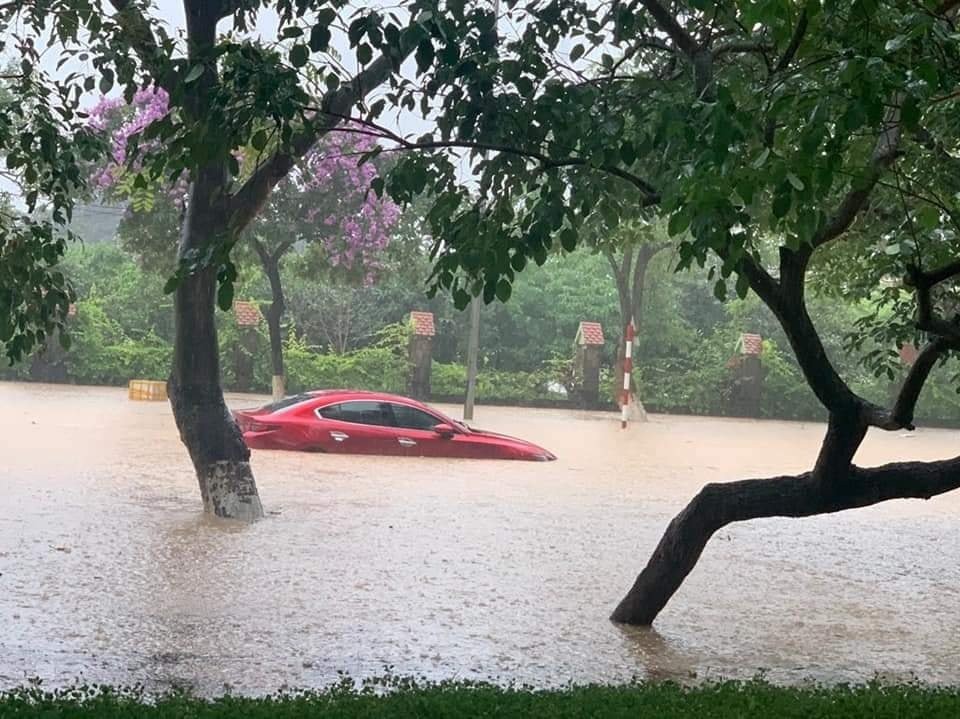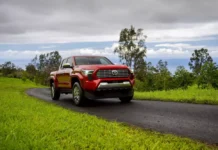With the prolonged heavy rains, it’s easy for the streets to flood, and knowing how to navigate your car through storms and floods safely becomes a mandatory “survival skill” for driving in the rainy season to minimize potential damage.
A car that stalls due to flooding is a much bigger problem than a motorcycle, as it not only causes severe damage to the engine and its components but also makes the rescue process quite cumbersome and time-consuming. So, how do you navigate through the sea of water during the rainy season? This article will highlight the things to keep in mind to help your car “survive” safely through the stormy and flooded days.
What to Do When Facing Storms
Driving in stormy weather can be challenging, as visibility is reduced, and unexpected situations can arise, making it difficult for drivers to maintain control. Therefore, to ensure a safe journey, keep the following in mind.
Turn Back if Possible
Many drivers stubbornly continue on a flooded road to save time and avoid turning back. However, if the water is too deep and other vehicles are not daring to enter, don’t be overconfident in your car’s “swimming” abilities. If you see people parking their motorcycles on the sidewalk and waiting for the water to recede, don’t attempt to drive through. Instead, turn back and choose a safer route. Rushing through can cause significant damage to your car, leading to costly repairs, and your car may still suffer from water hammer, a term used to describe the damage caused by water entering the engine.

During the rainy season, find the safest route and avoid taking unnecessary risks.
Observe and Assess the Water Depth
If you still want to attempt to drive through the flooded area, you must first observe and assess the situation, knowing the clearance height of your car. Typically, cars have a ground clearance of 160-180 mm, while 4×4 vehicles have a higher clearance of 200-250 mm, making them slightly better at wading through water.
The safe water level is usually at the center of the wheel, as the air intake of the car is often designed at the same height as the hood. If water enters the air intake, it can cause the engine to stall. So, you need to judge the depth of the flooded area you’re about to drive through and aim to keep the water level slightly lower to avoid the impact of oncoming vehicles.
To make the best judgment in this situation, the driver can rely on fixed elements on the road, such as curbs, trees, and other vehicles in front of them. A particular point of attention during the rainy season is open sewer manholes.

Do not attempt to restart your car if it stalls due to flooding. Instead, stay calm and call for assistance.
Maintain Steady Throttle, Avoid High RPM
Another critical principle when driving through water is to maintain a steady throttle. Some people believe that flooring the throttle and speeding through is the best way to get through, but this often leads to stalling and the need for a tow truck.
Revving the engine at high RPM pulls more air and water into the engine. Additionally, speeding creates large waves that can affect other vehicles, and if they do the same, water will inevitably enter your car’s air intake. Therefore, when wading through water, maintain a moderate speed, neither too fast nor too slow. Keep the RPM low and steady, and engage a lower gear to ensure the exhaust pushes water out and prevents flooding.
Typically, an RPM of 1,500-2,000 is ideal. Also, turn off electrical systems like air conditioning and the radio to maximize engine performance.
Avoid speeding to prevent affecting other vehicles.
What to Do After Wading Through Water
After successfully driving through a flooded area, don’t turn off the engine immediately. Continue driving for another 5-10 minutes to ensure any remaining water in the car evaporates and is blown out.
Quick “First Aid” Steps to Minimize Damage if Your Car Stalls Due to Flooding
Step 1: Do not attempt to restart the engine. Put the car in neutral (N) to make it easier to tow or push the vehicle. Remove the key from the ignition.
Step 2: Assess the water level outside. If the water is below the door level, you can step out of the car. If the water is higher than the door, do not open the door, as this will allow water to rush into the cabin. Instead, lower the window and exit through it.
Step 3: After exiting the vehicle, open the hood, and disconnect the battery terminals to prevent water from entering the engine compartment and causing a short circuit.
Step 4: Open the oil filler cap and check the dipstick. If the oil appears milky brown, water has entered the engine. If not, the engine is likely unaffected.
Step 5: Call for a tow truck to take your car to the workshop and contact your insurance company if you have coverage.
Even if your car makes it through a flooded area without stalling, it’s essential to inspect it for any water ingress. As soon as you reach a dry area, check the engine compartment for any damage or foreign objects, and look for water in the air filter or oil reservoir. If you notice any signs of water ingress, do not continue driving, as this could lead to water hammer and severe engine damage. Instead, call for assistance and have your car towed to a garage for inspection to prevent further issues.

A car unfortunately becoming a “submarine” in Vinh Phuc, Vietnam (Photo: Ha Van Hai)
At the end of the rainy season, it’s advisable to take your car for maintenance, oil change, and lubrication of the axle joints to prevent corrosion. Remember, “30 is not the end,” and getting through a flood doesn’t mean you’re out of the woods. Stay vigilant, drivers!
Protect Your Car Engine from the Very Beginning
Longevity is a key factor when it comes to owning a car. Instead of wasting excessive time and money, car owners can ensure the durability of their vehicles by grasping a few simple secrets. One of these secrets lies in the selection of the appropriate oil, which plays a crucial role in protecting the car right from the beginning.

































![[VIDEO] Unveiling the Secrets of a 2009 Toyota Camry with Almost 500,000 km Logged](https://vnauto.net/wp-content/uploads/2024/02/xehay-camry-100123-3_result-150x150.jpg)











